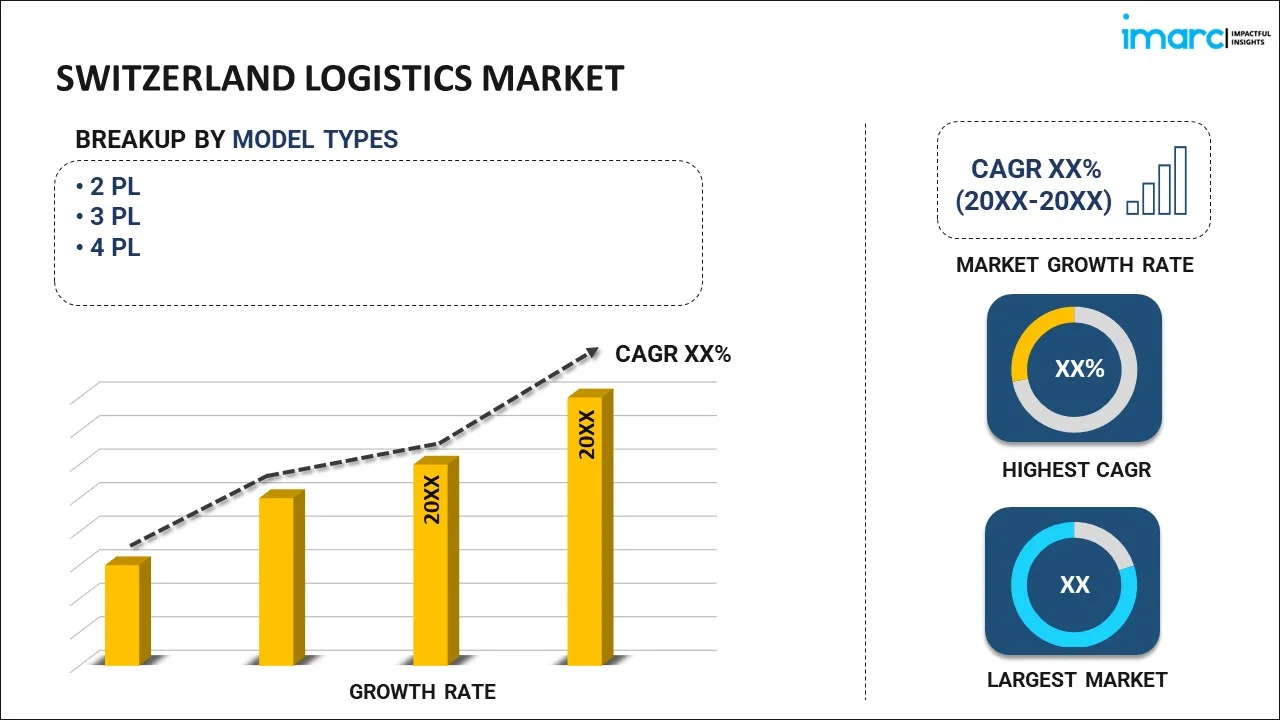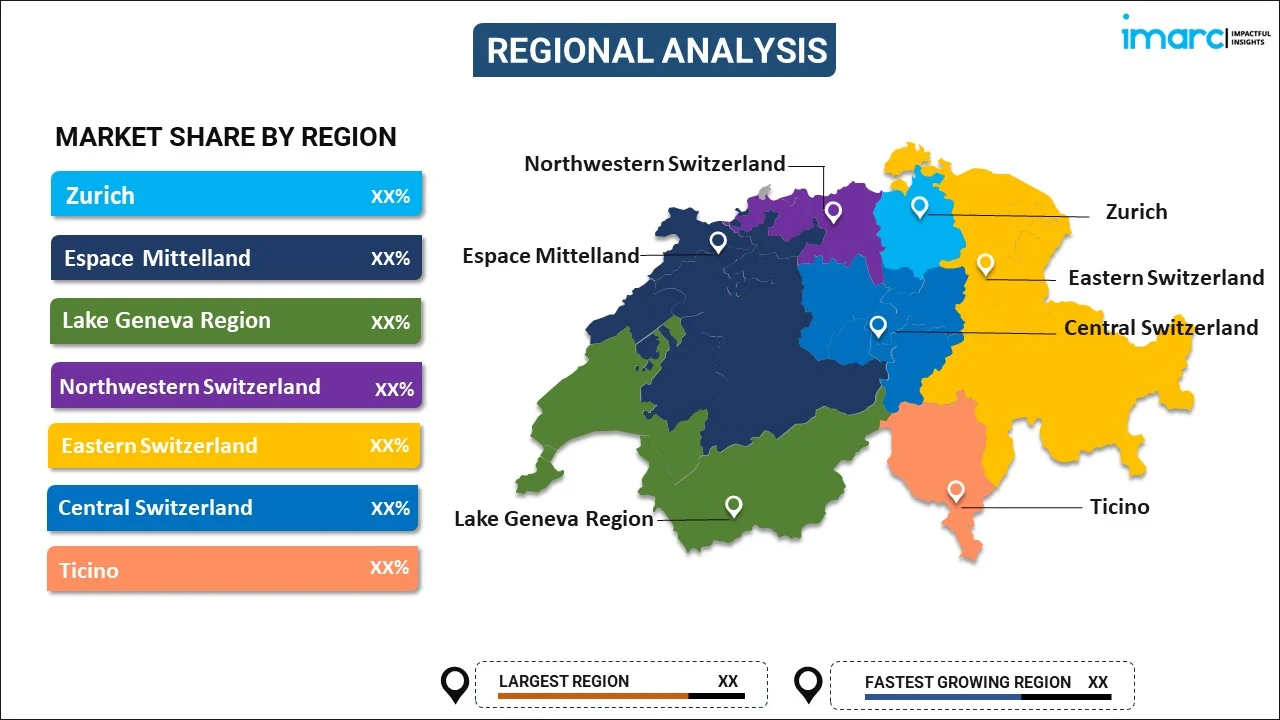
Switzerland Logistics Market Report by Model Type (2 PL, 3 PL, 4 PL), Transportation Mode (Roadways, Seaways, Railways, Airways), End Use (Manufacturing, Consumer Goods, Retail, Food and Beverages, IT Hardware, Healthcare, Chemicals, Construction, Automotive, Telecom, Oil and Gas, and Others), and Region 2025-2033
Switzerland Logistics Market Overview:
The Switzerland logistics market size reached USD 10.0 Billion in 2024. Looking forward, IMARC Group expects the market to reach USD 20.0 Billion by 2033, exhibiting a growth rate (CAGR) of 3.7% during 2025-2033. The expanding infrastructural development, growing demand for high-quality services, increasing e-commerce activities, adoption of advanced technology, and strong international trade relationships driving the need for efficient and reliable transportation and supply chain solutions are some of the key factors contributing to the market expansion.
|
Report Attribute
|
Key Statistics
|
|---|---|
|
Base Year
|
2024 |
|
Forecast Years
|
2025-2033
|
|
Historical Years
|
2019-2024
|
| Market Size in 2024 | USD 10.0 Billion |
| Market Forecast in 2033 | USD 20.0 Billion |
| Market Growth Rate (2025-2033) | 3.7% |
Switzerland Logistics Market Trends:
Advancements in digital technology and automation
Innovations such as the Internet of Things (IoT), big data analytics, artificial intelligence (AI), and blockchain are enabling more efficient and transparent logistics operations. IoT devices provide real-time tracking and monitoring of goods, improving inventory management and reducing losses. Big data analytics allow companies to analyze vast amounts of data to optimize supply chain processes, forecast demand more accurately, and enhance decision-making. AI and machine learning (ML) help optimize route planning and improve warehouse operations, leading to increased efficiency and reduced costs. Blockchain technology enhances transparency and security in the supply chain by providing immutable records of transactions and shipments. In addition to this, automation, including the use of robots and automated guided vehicles (AGVs) in warehouses boosts productivity and reduces the reliance on manual labor, thereby strengthening the market growth.
E-commerce boom and last-mile delivery innovations
As online shopping becomes increasingly popular, the demand for efficient and reliable delivery services has surged. Swiss consumers expect quick and convenient delivery options, pushing logistics providers to innovate and optimize last-mile delivery solutions. Companies are investing in advanced technologies such as automated warehouses, drones, and electric delivery vehicles to enhance efficiency and reduce delivery times. The development of smart logistics systems, incorporating real-time tracking and route optimization algorithms, is also playing a critical role in meeting consumer expectations. Moreover, the rise of e-commerce has led to increased warehousing needs, further driving investment in modern, strategically located logistics centers, thereby supporting the market expansion.
Emphasis on sustainability
The growing consumer awareness of climate change and environmental impact combined with the government’s stringent environmental regulations and incentives are driving the demand for green logistics solutions. As a result, logistics companies are embracing a range of environmentally sustainable practices, including the use of electric and hybrid vehicles, delivery route optimization to minimize fuel consumption, and the installation of energy-efficient technologies in warehouses. Moreover, the shift towards rail freight as a more environmentally friendly alternative to road transport is contributing to the market growth. Additionally, the increasing emphasis on sustainable packaging and reducing waste in the supply chain, aligning with Switzerland’s commitment to sustainability is impelling the market growth.
Switzerland Logistics Market News:
- In September 2023, Scan Global Logistics (SGL) acquired Belglobe GmbH, to bolster its position in the Pharma Healthcare and luxury consumables sectors. Switzerland's strong infrastructure and close proximity to important European markets allow SGL to expand its global network and improve distribution efficiency as well as access to supply chain management and central procurement for multinational corporations.
Switzerland Logistics Market Segmentation:
IMARC Group provides an analysis of the key trends in each segment of the market, along with forecasts at the country level for 2025-2033. Our report has categorized the market based on model type, transportation mode, and end use.
Model Type Insights:

- 2 PL
- 3 PL
- 4 PL
The report has provided a detailed breakup and analysis of the market based on the model type. This includes 2 PL, 3 PL, and 4 PL.
Transportation Mode Insights:
- Roadways
- Seaways
- Railways
- Airways
A detailed breakup and analysis of the market based on the transportation mode have also been provided in the report. This includes roadways, seaways, railways, and airways.
End Use Insights:
- Manufacturing
- Consumer Goods
- Retail
- Food and Beverages
- IT Hardware
- Healthcare
- Chemicals
- Construction
- Automotive
- Telecom
- Oil and Gas
- Others
The report has provided a detailed breakup and analysis of the market based on the end use. This includes manufacturing, consumer goods, retail, food and beverages, IT hardware, healthcare, chemicals, construction, automotive, telecom, oil and gas, and others.
Regional Insights:

- Zurich
- Espace Mittelland
- Lake Geneva Region
- Northwestern Switzerland
- Eastern Switzerland
- Central Switzerland
- Ticino
The report has also provided a comprehensive analysis of all the major regional markets, which include Zurich, Espace Mittelland, Lake Geneva Region, Northwestern Switzerland, Eastern Switzerland, Central Switzerland and Ticino.
Competitive Landscape:
The market research report has also provided a comprehensive analysis of the competitive landscape. Competitive analysis such as market structure, key player positioning, top winning strategies, competitive dashboard, and company evaluation quadrant has been covered in the report. Also, detailed profiles of all major companies have been provided.
Switzerland Logistics Market Report Coverage:
| Report Features | Details |
|---|---|
| Base Year of the Analysis | 2024 |
| Historical Period | 2019-2024 |
| Forecast Period | 2025-2033 |
| Units | Billion USD |
| Scope of the Report | Exploration of Historical Trends and Market Outlook, Industry Catalysts and Challenges, Segment-Wise Historical and Future Market Assessment:
|
| Model Types Covered | 2 PL, 3 PL, 4 PL |
| Transportation Modes Covered | Roadways, Seaways, Railways, Airways |
| End Uses Covered | Manufacturing, Consumer Goods, Retail, Food and Beverages, IT Hardware, Healthcare, Chemicals, Construction, Automotive, Telecom, Oil and Gas, Others |
| Regions Covered | Zurich, Espace Mittelland, Lake Geneva Region, Northwestern Switzerland, Eastern Switzerland, Central Switzerland, Ticino |
| Customization Scope | 10% Free Customization |
| Post-Sale Analyst Support | 10-12 Weeks |
| Delivery Format | PDF and Excel through Email (We can also provide the editable version of the report in PPT/Word format on special request) |
Key Questions Answered in This Report:
- How has the Switzerland logistics market performed so far and how will it perform in the coming years?
- What has been the impact of COVID-19 on the Switzerland logistics market?
- What is the breakup of the Switzerland logistics market on the basis of model type?
- What is the breakup of the Switzerland logistics market on the basis of transportation mode?
- What is the breakup of the Switzerland logistics market on the basis of end use?
- What are the various stages in the value chain of the Switzerland logistics market?
- What are the key driving factors and challenges in the Switzerland logistics?
- What is the structure of the Switzerland logistics market and who are the key players?
- What is the degree of competition in the Switzerland logistics market?
Key Benefits for Stakeholders:
- IMARC’s industry report offers a comprehensive quantitative analysis of various market segments, historical and current market trends, market forecasts, and dynamics of the Switzerland logistics market from 2019-2033.
- The research report provides the latest information on the market drivers, challenges, and opportunities in the Switzerland logistics market.
- Porter's five forces analysis assist stakeholders in assessing the impact of new entrants, competitive rivalry, supplier power, buyer power, and the threat of substitution. It helps stakeholders to analyze the level of competition within the Switzerland logistics industry and its attractiveness.
- Competitive landscape allows stakeholders to understand their competitive environment and provides an insight into the current positions of key players in the market.
Need more help?
- Speak to our experienced analysts for insights on the current market scenarios.
- Include additional segments and countries to customize the report as per your requirement.
- Gain an unparalleled competitive advantage in your domain by understanding how to utilize the report and positively impacting your operations and revenue.
- For further assistance, please connect with our analysts.
 Inquire Before Buying
Inquire Before Buying
 Speak to an Analyst
Speak to an Analyst
 Request Brochure
Request Brochure
 Request Customization
Request Customization




.webp)




.webp)












